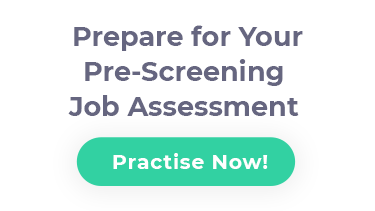Train Driver Assessment Test Preparation – 2025

What Is the Hiring Process for Train Drivers?
Train driving positions are competitive, and the process is rigorous. This is because the job comes with great responsibility, so the candidates must be the best of the best. The hiring process consists of a variety of hurdles jump over. These hurdles include tests, interviews, and other exercises designed to appraise cognitive, social, and emotional abilities. There is a total of four stages. The entire selection process for train drivers takes, on average, three to four weeks.
Application Process
The application is the company’s first impression of the candidate. This impression goes much further than credentials and experience, the applicant should also detail accomplishments and provide thoughtful answers for the competency-based questions included in the application form. Applicants should provide as much relevant information as possible so that the company can get the best possible outline of the candidate and their skills.
Train Driver Assessments
The assessments are sent to the candidate via email after the application has been reviewed. The assessments measure aptitude, technical ability, and behaviour. The train driving assessments include:
- Fault Finding Test
The fault-finding assessment gauges the test taker’s ability to draw conclusions from ambiguous data and observations. This is a necessary skill for job seekers interested in mechanics. The questions employ a variety of shapes and figures to demonstrate an action or movement. It is the test taker’s job to complete these movements or correct mistakes they may encounter. The results of the test inform the administrator of the assessment of the test taker’s inductive and abstract reasoning skills.
- Logical Reasoning
The logical reasoning test is another non-verbal assessment commonly administered to candidates for train driving positions. The shapes are arranged in specific sequences with the last shape left blank. From a list of answer choices, the candidate must choose which shape would logically appear next in the sequence. The patterns are routinely depicted by changes in position, shape, colour, or frequency. The results of the assessment inform the company of the candidate’s ability to identify patterns and utilise deductive and inductive reasoning.
- Numerical Comprehension
The numerical comprehension assessment evaluates the test taker’s mathematical abilities including understanding quantitative data, interpreting graphs, and performing basic calculations. The questions are all multiple-choice and timed. Three to five questions are paired with a table or graph. The test taker must analyse the numerical data to accurately address and answer the questions. It is important to note that there are a few trick answer choices in the numerical comprehension test.
- Personality Questionnaire
The personality questionnaire is a behavioural test that offers the company insight into the candidate’s work preferences and temperament. The questionnaire presents a series of statements that the candidate must rate as “Agree” or “Disagree”. The results of this questionnaire will be compared with the company’s preferred personality traits and behaviour for the position.
- Situational Judgment Test (SJT)
The SJT is similar to the personality test, but with a few key differences. Both of these assessments are behavioural and help the company get an idea of the candidates working style, but the SJT gets a little more in-depth. The SJT provides an array of hypothetical scenarios followed by a proposed course of action. The test taker must rate how appropriate the action was for the given scenario. The scenarios range from everyday occurrences to conflicts or stressful situations. The SJT is multiple-choice and its chief focus is the candidate’s emotional intelligence.
- Train Driver Mechanical Reasoning
The mechanical reasoning test consists of basic mechanical problems and principles. The candidate should have an understanding of the fundamentals of physics to be successful in this assessment. The questions may illustrate a motion or principle, or the questions may ask about terminology and real-world application. The candidate is allotted thirty seconds to answer each multiple-choice question.
- Verbal Comprehension
The verbal comprehension test is important because it assesses the candidate’s ability to understand written instructions or procedures. Again, there are only thirty seconds given to answer each multiple-choice question. This test is commonly structured with brief passages and follow-up questions. The passages discuss a random topic to highlight the candidate’s capacity for understanding novel information. Subsequently, three to five questions will assess how well the candidate comprehended the provided information.
Assessment Centre
The assessment centre is the third stage of the Train Driver selection process. Here, the candidates will spend a half-day with trained assessors at one of the company’s main offices. Most of the activities are aptitude and competency assessments. A few of the assessments at the assessment centre will be retakes of the online assessments taken during the previous stage.
Common tests administered at the assessment centre are:
- Concentration Test
The concentration test is a two-minute, five-page assessment. The candidate must look through pages of dots and mark where four-dot combinations occur. The skills assessed during the concentration test include being able to offer consistent results when performing a dull task and performing multiple tasks at once. These traits are among the most important train drivers can possess.
- Reaction & Co-ordination Assessment
The reaction & co-ordination assessment verifies the results of the concentration test. This test, unlike the concentration test, uses colourful shapes. The objective is to select the right colour and shape when instructed to do so. The test gets increasingly faster and more difficult as it progresses.
- Rules & Procedures Assessment
The rules and procedures assessment resembles a memory test. The candidate must be able to recite verbal and written instructions and apply to them to any given task. There are two parts to this test. The first part involves listening to instructions for a job-specific task and then correctly completing the task. The second part consists of a set of written instructions rather than verbal ones. The candidate must then use these instructions to answer a handful of multiple-choice questions.
Train Driver’s Interview
The interview is the final stage of the train driver hiring process. The final interview is conducted in-person with a senior member of the company and can last anywhere from thirty minutes to an hour.
At the interview, the assessor will ask competency-based and technical questions. These questions will be about past experiences, relevant accomplishments and qualifications, and may also include solving hypothetical problems posed by the interviewer. Common interview questions are:
- Tell me about a time when you had run into a conflict with one of your superiors.
- Tell me about a time when you took initiative.
- Tell me about a time when you worked by yourself for a long period.
- What skills do you have that make you the perfect candidate for this role?
How to Prepare the Train Driver Assessments?
On average, 300 candidates are turned down per open position. This makes the selection process very high stakes. The majority of candidates are cut during the assessment stage for failing to meet the company’s benchmarks. To prevent this from happening so you can move to the next step, it is important that you prepare for anything these assessments may throw at you.
One of the most effective ways to prepare for these assessments is by using online practice tests. These practice tests simulate the questions and time limits of the genuine assessments and come in short and full-length versions for all of your preparation needs. These tests are especially helpful if you feel that the time limits may be a problem or source of stress for you. Practising with these tests is the best way to put your mind at ease. Additionally, you have the option to see your score at the end of the test. Your score will tell you a few things such as how well you might do on the real assessment and how much more practice you will need to put in before you’re ready.
The behavioural tests are a different story. The answers are subjective which means that the companies may prefer one over the other depending on with whom you are interviewing. To get an idea of what the company is looking for in their candidates, do some background research. Review the company’s values, reread the job posting to see if they outlined any particular competencies, and check out the company’s website for more information about them. These resources will help you align your answers to the company’s preferences, so you can be presented in the best possible light.
Train Driver Selection Process Tips
There are a handful of universal skills that company’s look for in train drivers. These skills are the subject of a variety of interview and test questions. It is important that you review them and find examples of how and when you have demonstrated these skills both personally and professionally. These skills include the following:
- Ability to Follow Instructions
- Ability to Handle Stressful Situations
- Customer-Focus
- Flexible
- Safety Awareness
- Selective Attention
- Responsible
The interviewer may ask a competency-based question such as “Describe a time you have had to deal with an irate customer”. Your answer should demonstrate your ability to handle stressful situations, act responsibly, and keep the customer’s interest in mind.
The number one thing is to put your best foot forward. With devoted preparation, this shouldn’t be too hard. Best of luck!
Leading Train Companies in UK & Europe:
| HŽ |
RB |
FNM |
SNCB |
East Midlands Railway |
Thameslink |
Metro de Málaga |
| ČD |
c2c |
FTC |
SNCF |
Great Western Railway |
Merseyrail |
Abellio ScotRail |
| VR |
ÖBB |
MSP |
TCDD |
South Western Railway |
Canfranero |
Grand Central |
| DB |
DSB |
FGC |
STLB |
Rail Traction Company |
Colas Rail |
Heathrow Express |
| IÉ |
EVR |
LAV |
BSMJ |
Rail Operations Group |
Hull Trains |
Metro de Granada |
| FS |
OSE |
BLS |
SSIF |
South Eastern Railway |
Green Cargo |
Metro de Sevilla |
| NS |
ΟΣΕ |
BOB |
BHÉV |
Ferrovia Roma Viterbo |
CrossCountry |
Avanti West Coast |
| CP |
MÁV |
BVZ |
ZSCS |
Govia Thameslink Railway |
Southeastern |
Chiltern Railways |
| SJ |
ZHB |
GPL |
RENFE |
Ferrovia Roma Ostia Lido |
Freightliner |
East Coast Trains |
| BR |
CFL |
MGB |
GySEV |
Locomotive Services Limited |
Grand Central |
Arriva Rail London |
| ZB |
ŽCG |
RBS |
ROeEE |
London North Eastern Railway |
Greater Anglia |
Caledonian Sleeper |
| VB |
NSB |
VAE |
DCRail |
Bentheimer Eisenbahn |
GB Railfreight |
Rail Cargo Austria |
| TK |
PKP |
TPC |
Railion |
Metro de Barcelona |
Riviera Trains |
Metro de Madrid |
| SV |
SBB |
WTE |
Rhealys |
Metro de Santander |
Vintage Trains |
Great Northern |
| AB |
CFF |
IVB |
Eurostar |
TransPennine Express |
Cercanías |
Northern Trains |
| FO |
FFS |
LLB |
TfL Rail |
West Midlands Trains |
Southern |
Gatwick Express |
| GE |
VFS |
WLB |
NMBS |
West Coast Railways |
Northern |
Cargo railways |
| GB |
GKB |
LTE |
MOB |
Transport for Wales |
FS Cargo |
DB Cargo UK |
| JB |
SLB |
HzL |
SA |
Direct Rail Services |
|
|

